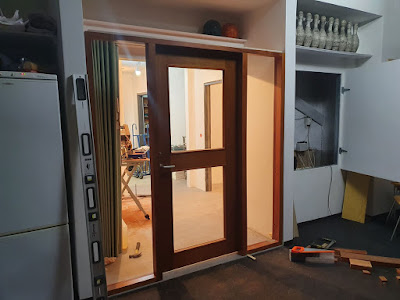Insane Eisenberg V8 Bike Delivers 500 HP – It’s Road Legal
Britain’s Eisenberg Racing fitted a V8 engine on a custom motorcycle. The engine displacement is 3000cc while the total output is staggering – 500 hp (if it runs on racing fuel) and 480 hp (on standard gas). The man behind this project is Zef Eisenberg and as hard to believe as it is, the motorcycle is still running some tests in order to become road legal.
Hjólið heitir Eisenberg EV8 og var hann að af manni með sama nafni.
Í hjólinu er V8 3000cc mótor sem var hannaður af nokkrum af bestu vélsmiðum Englands,
Takmarkið var að búa til V8 mótor með rétta hæð ,þyngd og lengd þannig að það myndi ekki hafa mikil áhrif á ökuhæfni hjólsins. Smíðin tók 4 ár og má með sanni segja að þetta sé með þeim flottari V8 hjólum sem sést hafa. 500 hestöfl við 10500 snúninga. Vélin er lygilega létt miðað við V8 því hun vegur aðeins 80 kg og að ná þessum hestöflum út án þess að nota nitró eða turbó er magnað.
Hámarkshraðinn: með öllu þessu afli! hvað kemst það hratt? Í vélaprófunum fór hjólið í 333km hraða en þeir segja að það fari auðveldlega í 362 km og eins og áður segir án Turbó, blower, Nos og án þess að vera með hlífar á sér.
Með vindhlífum telja þeir að hjólið fari yfir 400 km/klst.
The Engine
Besides the power figures, this V8 engine is different from what you see fit on an American muscle car for example. In other words, a crossplane crankshaft design giving the engine that typical ‘chevy v8’ burble sound thanks to the uneven exhaust pulses. As a result, the American muscle car V8 engines are heavier and bulkier due to the heavy balance shaft which makes them quite a challenge when they are used on motorcycles. The Eisenberg V8 engine, on the other hand, features a flatplane crankshaft which delivers even exhaust pulses. Also, the V8 engine can rev much higher and easier compared to a V8 with a crossplane crankshaft. As an end result, it delivers more hp, it’s revvier, it uses a smaller displacement and it weighs less thanks to the compact design features.
The Eisenberg V8 features eight independent fly by wire, Jenvy throttle bodies with tuned trumpet lengths to provide better airflow and throttle response. The throttle bodies are controlled by a bespoke ECU which offers full ride by wire. As a result, the rider can manage the maximum power delivery of the motorcycle without the need to use various menu controlled power maps. Furthermore, the experienced riders will receive a special red key that, when activated allows full control of the Eisenberg EV8 without electronic intervention.
It took over two years to design the special 6-speed gearbox and as Eisenberg claims, the gearbox was dyno tested and patented. To sustain such a high power delivery, the gearbox features some special elements such a swappable primary gears as we see fitted on GP race bikes.
The Eisenberg EV8 was equipped with a reverse spinning clutch which counteracts gyroscopic inertia. It’s a technical solution used to counteract the considerable inertial response when the rider twists the throttle.
Moreover, the motorcycle features a concentric swingarm design with anti-squat geometry to reduce chain tension issues. By using a smaller 530 chain (rather than a heavier 630) the friction level is reduced and the engine doesn’t lose any horsepower. All in all, it’s a technical solution we don’t get to see on most of the bikes out there. The swingarm alone is made using CNC and billet aluminium that shreds off some kilos to keep the bike’s weight down. The whole bike, especially around the engine, was designed to handle the full stress put through the frame and powertrain.
The Eisenberg EV8 is still in the prototype phase of development and it’s put through its paces going under continuous engine dyno and road testing to make sure that the production bike provides a smooth clutch feel, handling, gearbox, rideability, engine cooling and so on.
The production version of the is underway, but it will have to comply with a bunch of legislation rules in order to actually see it run on the streets. Of course, there’s a price to pay for all this performance and in the UK the price tag will be set around £100,000 (close to US$130,000) which might increase until the production version is completed.





















